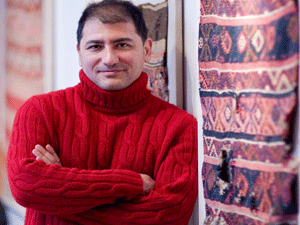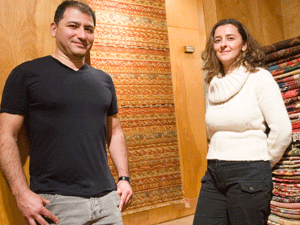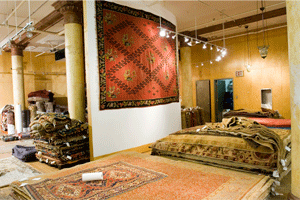The Apex of Turkish Carpets in New York
- Written by Admin TOA
- Published in Businessman
Around two years ago, at a carpet trade fair in the North Carolina city of Asheville, considered by many to be the heart of the carpet industry, an old Turkish carpet which was put up for open bidding was sold for exactly 279,000 dollars, despite the fact it had only been expected to go for between 5 and 10 thousand dollars.
Trade fair attendees were shocked. Though the carpet had been thought to date from sometime in the 18th century, Milanese carpet salesman Moshe Tabibnia understood that it had been woven sometime in the mid-1500s, and the prices went up. With this, it was also disclosed that the carpet had been woven in the Konya village of Karapınar.

Though no one may know where and how the world's first carpet was woven, it is true that the Turks have been weaving carpets in Anatolia since the 11th century. The development of carpet and rug weaving in Anatolia owes its thanks to Turkish tribes that migrated from Central Asia. During the 16th, 17th, and 18th centuries, in places like Gördes, Kula, Milas, Ladik, Mucur (Kirsehir), Bandırma, and Çanakkale, weaving grew in importance. During the Ottoman Empire, a weaving atolier set up in Hereke gained fame for its weaving of carpets solely for the Ottoman sultans.
During the 18th century, the fact that weaving looms were referred to as "Turkish weaving looms" proved the widespread status of Turkish carpets throughout Europe.
And thus Turkish weaving moved from Central Asia to Anatolia, and from Anatolia to the West, where now Asia Minor Carpets represents them in the US. With its Turkish owner, Asia Minor Carpets has managed to stay on its feet despite tough competition, and is the largest wholesale seller of carpets in the US. Asia Minor Carpets was established in 1984 on New York City's Lexington Avenue by Alparslan Başdoğan, the third generation of Adana's Başdoğan famiy to deal in this sector.
Asia Minor Carpets has showrooms in Atlanta, GA and High Point, NC, both considered carpet centers in the US. The Turkish-owned company sells around 6,000 square meters of carpet, and 3,000 square meters of rugs annually. Asia Minor Carpets also has a restaurant in Vermont which sells carpets. And in Istanbul and Adana, there are carpet sales stores offering carpets carrying the Başdoğan label.
Asia Minor carpets are woven at different atolier locations throughout the inner Anatolia region; around 1,600 carpet weavers are employed in the weaving of these carpets, and the final products go to Adana where they go through their final processes before being sent out. Around 80% of these carpets are exported to the US.
Asia Minor Carpet's Fifth Avenue headquarters contains around 2,000 different carpets. There are nine people employed here, in a family atmosphere. Owner Alparslan Başdoğan makes the final decisions on the carpets' designs, and on the make-up of the collections. In terms of deciding the final carpet lines, his sister Hatice is in charge, while his brother Ertuğrul guides the production, and his father Mehmet Başdoğan oversees the purchase of raw materials.
Alparslan Başdoğan, who studied international import-export at the University of Michigan, asserts that in order for Turkish carpets to become better known across the US, there needs to be more people selling real Turkish carpets in the country.
The 9 by 12 meter carpet that lies in the salon at Asia Minor Carpets took around four months to be woven by a team of four people. These carpets, which are woven using only 100% Turkish wool, range between $3,500 and $4,000 per carpet, depending on design and model.

Başdoğan's closest assistant at the business is Leyla Eroğlu, who notes that the spreading popularity of Chinese carpets on the market has forced many other firms to draw back their businesses. The reason that Asia Minor Carpets has managed to stay on its feet despite all this is that it produces original carpets which require a great deal of handiwork. She says, "The fact that we have no real competition in terms of Turkish handmade carpets makes it harder to promote Turkish carpets in general. While there are hundreds of firms vying to promote Iranian carpets, there is only a handful of firms doing the same for Turkish carpets.”
The marketing of Turkish carpets is generally done by foreigners. One of these is retired American military official Stan Akins, who imports carpets from Turkey to sell in the US. Akins first encountered Turkish carpets when he was working as a air force officer; he has been selling them for the past 30 years, and for the past 10 at the Pasquotank Arts Council Gallery in Elizabeth City, NC.
Başdoğan asserts that the beginning of the end of many Turkish carpet firms in the US market is that they start wrestling with the idea, "How can we produce cheaper carpets than the Indian and Chinese carpets?" He asserts, "They never thought anything contrary to that. When in truth, it is the raw materials that go into these carpets and the people who weave them that make the difference. They weren't able to see this truth."
According to figures from the American Statistics Bureau, Turkish exports of carpets and other floor covering products to the US market totalled 80.7 million dollars in 2006. In 2005, this figure was 75.2 million dollars. Başdoğan notes that in fact there is great potential in the US for this sector, but that the potential is not being tapped. He notes that some carpet merchants sell Turkish handwoven carpets in an ignorant manner, thus damaging the name of the sector. He says, "They will sell a carpet made of Turkish designs but woven cheaply in China as a Turkish carpet. Thus the sector and Turkish carpets as a whole are being damaged in terms of their image." He goes on: "There are no carpets in the world that have the design and quality of Turkish carpets. It's up to us to make sure this culture survives, and is passed on to future generations. Carpet producers need to ask themselves how they can stop competing with India and China, and focus on how they can modernize and make even better carpets."

AWARD WINNING CARPETS
Aside from carpets, Asia Minor also sells furniture products. Some of their sitting room furniture is covered in kilim designs. Başdoğan's office walls are covered in awards that some of his carpets have received. Some of his carpets won two main prizes at the 1994 International Carpet Display Show in Atlanta. Another of the interesting carpets in his office is one that was woven in an Ottoman palace and then sent abroad. This is one that Başdoğan came across by accident at a Washington, DC carpet merchant's shop.
(December 2007, 27th Issue)

Alparslan Basdogan, President of Asia Minor Carpets. (By Ayhan Kay)
Though no one may know where and how the world's first carpet was woven, it is true that the Turks have been weaving carpets in Anatolia since the 11th century. The development of carpet and rug weaving in Anatolia owes its thanks to Turkish tribes that migrated from Central Asia. During the 16th, 17th, and 18th centuries, in places like Gördes, Kula, Milas, Ladik, Mucur (Kirsehir), Bandırma, and Çanakkale, weaving grew in importance. During the Ottoman Empire, a weaving atolier set up in Hereke gained fame for its weaving of carpets solely for the Ottoman sultans.
During the 18th century, the fact that weaving looms were referred to as "Turkish weaving looms" proved the widespread status of Turkish carpets throughout Europe.
And thus Turkish weaving moved from Central Asia to Anatolia, and from Anatolia to the West, where now Asia Minor Carpets represents them in the US. With its Turkish owner, Asia Minor Carpets has managed to stay on its feet despite tough competition, and is the largest wholesale seller of carpets in the US. Asia Minor Carpets was established in 1984 on New York City's Lexington Avenue by Alparslan Başdoğan, the third generation of Adana's Başdoğan famiy to deal in this sector.
Asia Minor Carpets has showrooms in Atlanta, GA and High Point, NC, both considered carpet centers in the US. The Turkish-owned company sells around 6,000 square meters of carpet, and 3,000 square meters of rugs annually. Asia Minor Carpets also has a restaurant in Vermont which sells carpets. And in Istanbul and Adana, there are carpet sales stores offering carpets carrying the Başdoğan label.
Asia Minor carpets are woven at different atolier locations throughout the inner Anatolia region; around 1,600 carpet weavers are employed in the weaving of these carpets, and the final products go to Adana where they go through their final processes before being sent out. Around 80% of these carpets are exported to the US.
Asia Minor Carpet's Fifth Avenue headquarters contains around 2,000 different carpets. There are nine people employed here, in a family atmosphere. Owner Alparslan Başdoğan makes the final decisions on the carpets' designs, and on the make-up of the collections. In terms of deciding the final carpet lines, his sister Hatice is in charge, while his brother Ertuğrul guides the production, and his father Mehmet Başdoğan oversees the purchase of raw materials.
Alparslan Başdoğan, who studied international import-export at the University of Michigan, asserts that in order for Turkish carpets to become better known across the US, there needs to be more people selling real Turkish carpets in the country.
The 9 by 12 meter carpet that lies in the salon at Asia Minor Carpets took around four months to be woven by a team of four people. These carpets, which are woven using only 100% Turkish wool, range between $3,500 and $4,000 per carpet, depending on design and model.

Basdogan with his manager, Leyla Eroglu. (By Ayhan Kay)
Başdoğan's closest assistant at the business is Leyla Eroğlu, who notes that the spreading popularity of Chinese carpets on the market has forced many other firms to draw back their businesses. The reason that Asia Minor Carpets has managed to stay on its feet despite all this is that it produces original carpets which require a great deal of handiwork. She says, "The fact that we have no real competition in terms of Turkish handmade carpets makes it harder to promote Turkish carpets in general. While there are hundreds of firms vying to promote Iranian carpets, there is only a handful of firms doing the same for Turkish carpets.”
The marketing of Turkish carpets is generally done by foreigners. One of these is retired American military official Stan Akins, who imports carpets from Turkey to sell in the US. Akins first encountered Turkish carpets when he was working as a air force officer; he has been selling them for the past 30 years, and for the past 10 at the Pasquotank Arts Council Gallery in Elizabeth City, NC.
Başdoğan asserts that the beginning of the end of many Turkish carpet firms in the US market is that they start wrestling with the idea, "How can we produce cheaper carpets than the Indian and Chinese carpets?" He asserts, "They never thought anything contrary to that. When in truth, it is the raw materials that go into these carpets and the people who weave them that make the difference. They weren't able to see this truth."
According to figures from the American Statistics Bureau, Turkish exports of carpets and other floor covering products to the US market totalled 80.7 million dollars in 2006. In 2005, this figure was 75.2 million dollars. Başdoğan notes that in fact there is great potential in the US for this sector, but that the potential is not being tapped. He notes that some carpet merchants sell Turkish handwoven carpets in an ignorant manner, thus damaging the name of the sector. He says, "They will sell a carpet made of Turkish designs but woven cheaply in China as a Turkish carpet. Thus the sector and Turkish carpets as a whole are being damaged in terms of their image." He goes on: "There are no carpets in the world that have the design and quality of Turkish carpets. It's up to us to make sure this culture survives, and is passed on to future generations. Carpet producers need to ask themselves how they can stop competing with India and China, and focus on how they can modernize and make even better carpets."

Asia Minor Carpets New York' store. (By Ayhan Kay)
AWARD WINNING CARPETS
Aside from carpets, Asia Minor also sells furniture products. Some of their sitting room furniture is covered in kilim designs. Başdoğan's office walls are covered in awards that some of his carpets have received. Some of his carpets won two main prizes at the 1994 International Carpet Display Show in Atlanta. Another of the interesting carpets in his office is one that was woven in an Ottoman palace and then sent abroad. This is one that Başdoğan came across by accident at a Washington, DC carpet merchant's shop.
(December 2007, 27th Issue)
Last modified onSaturday, 06 May 2017 10:07
Tagged under
Latest from Admin TOA
- 300 migrants to be housed at shuttered Catholic church on Northwest Side in Chicago
- Turkish Stand-Up Sensation Hasan Can Kaya Embarks on U.S. Tour with Art Evi Production, in212 Production, and TAAS New York
- "Lean Startup, To Lean Company, To Rich Exit" by Dr. Kenan Sahin is released with Forbes Books
- LOSEV USA Ramadan Campaign Let the Children Heal First with Your Ramadan Donations
- Azerbaijan Society of America Honors Centennial Anniversary of the Great Azerbaijani Politician the National Leader of Azerbaijan President Heydar Aliyev
